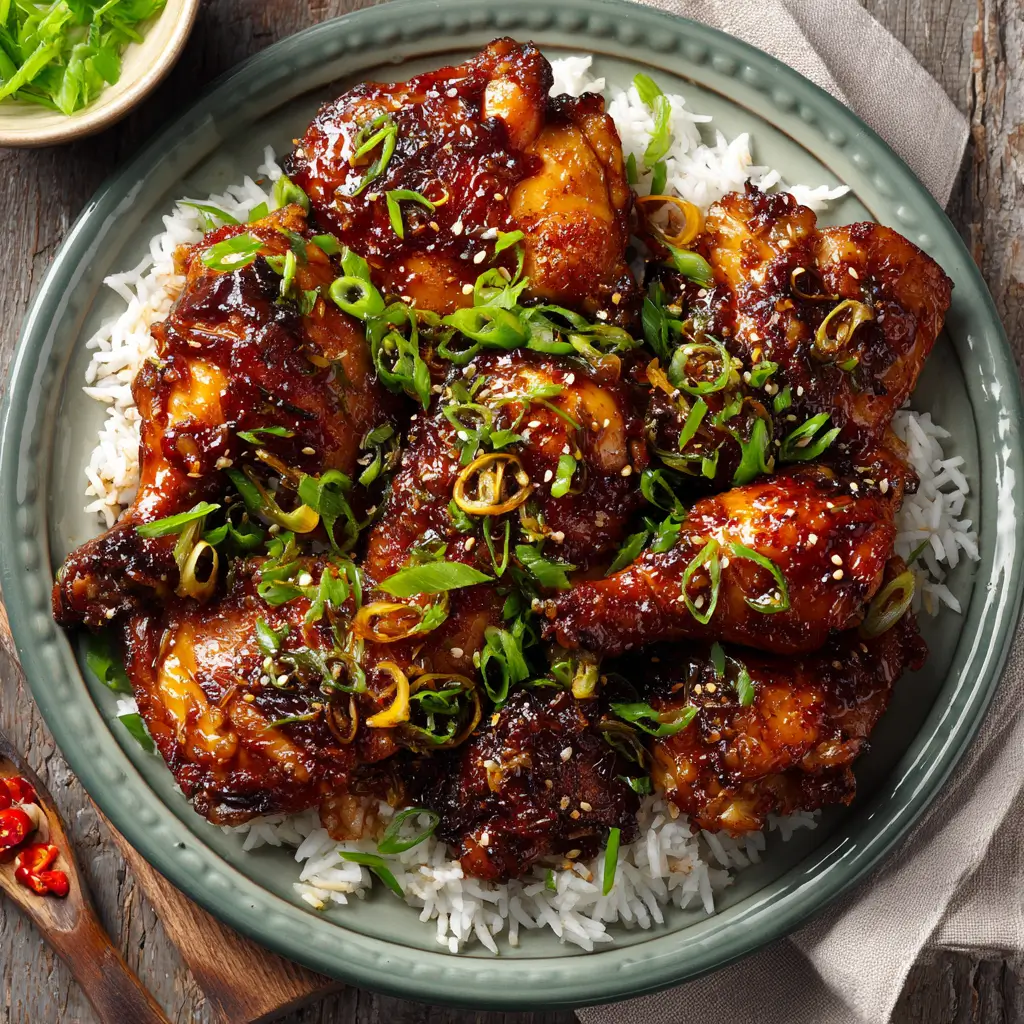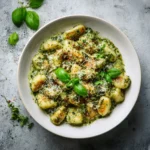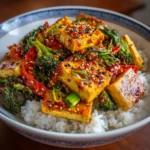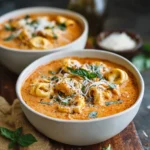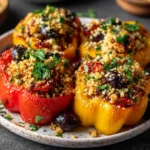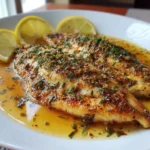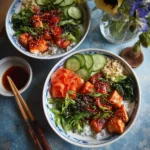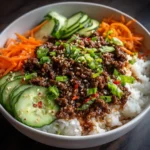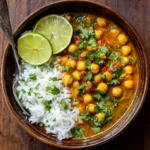Sticky Soy Garlic Chicken: A Flavorful and Irresistible Dish
Introduction
Sticky Soy Garlic Chicken is a mouthwatering fusion of savory, sweet, and umami flavors that has become a staple in both home kitchens and Asian-inspired restaurants around the world. This dish combines tender pieces of chicken with a rich, glossy sauce made from soy sauce, garlic, honey, and other aromatic ingredients to create a meal that’s as satisfying as it is simple to prepare. Whether served over steamed rice, quinoa, or alongside stir-fried vegetables, Sticky Soy Garlic Chicken delivers bold flavor in every bite. Its popularity stems not only from its delicious taste but also from its versatility, ease of preparation, and ability to be customized for different dietary preferences.
The appeal of this dish lies in its perfect balance—salty soy sauce tempered by the natural sweetness of honey or brown sugar, elevated by pungent garlic and enhanced with a hint of ginger and sesame oil. The result is a sticky glaze that clings beautifully to juicy chicken morsels, creating an appetizing sheen and unforgettable depth of flavor. It’s no wonder that this recipe has gained widespread acclaim among food lovers seeking comfort with an international flair.
The History
While Sticky Soy Garlic Chicken as we know it today may not trace back to a single country or century, its roots are deeply embedded in East and Southeast Asian culinary traditions. Soy sauce has been a cornerstone of Chinese cooking for over 2,500 years, originally developed during the Zhou Dynasty as a method of fermenting soybeans to preserve and enhance flavor. Over time, soy sauce spread throughout Asia, influencing Japanese, Korean, Vietnamese, and Thai cuisines.
Garlic, another essential component, has been used globally for thousands of years both for its medicinal properties and robust flavor. In traditional Chinese medicine, garlic was prized for its ability to boost immunity and improve circulation. When combined with soy sauce, these two ingredients formed the foundation of countless savory sauces and marinades across Asia.
The modern “sticky” version of soy garlic chicken likely emerged from the fusion of traditional Asian techniques with Western palates’ growing preference for sweet-savory profiles. Dishes like Korean Dakgangjeong (crispy fried chicken in sweet red pepper sauce) and Chinese General Tso’s Chicken influenced the development of recipes featuring crispy or seared chicken coated in thick, glossy sauces. Sticky Soy Garlic Chicken evolved as a simplified, family-friendly adaptation that could be made quickly at home without sacrificing complexity of flavor.
In recent decades, social media, food blogs, and cooking shows have helped popularize this dish worldwide, often under names like “Honey Soy Chicken” or “Garlicky Soy Glazed Chicken.” Today, it stands as a beloved example of how global ingredients and techniques can come together to form something universally appealing—a dish that feels both exotic and comforting at once.
Ingredients Breakdown
To achieve the signature taste and texture of Sticky Soy Garlic Chicken, each ingredient plays a crucial role. Below is a detailed breakdown of what goes into this delectable dish:
- Chicken (Boneless, Skinless Thighs or Breasts): Chicken thighs are preferred for their tenderness and richer flavor, which holds up well during cooking and absorbs the sauce beautifully. However, chicken breasts can be used for a leaner option, though they require careful cooking to avoid drying out.
- Soy Sauce (Low-Sodium Recommended): Provides the foundational umami and saltiness. Using low-sodium soy sauce allows better control over the overall salt content while still delivering deep flavor.
- Honey: Acts as the primary sweetener and contributes to the sticky, glossy finish. Honey also helps caramelize the chicken slightly when cooked, enhancing color and depth.
- Fresh Garlic (Minced): Offers a sharp, aromatic punch that intensifies as it cooks. Fresh garlic is superior to powdered in this recipe for maximum fragrance and flavor release.
- Fresh Ginger (Grated): Adds a warm, zesty note that complements the garlic and cuts through the richness of the sauce.
- Rice Vinegar: Introduces a mild acidity that balances the sweetness and prevents the sauce from being overly cloying.
- Sesame Oil: Imparts a nutty aroma and enhances the overall complexity of the dish. Just a small amount adds significant flavor.
- Water or Chicken Broth: Used to adjust the consistency of the sauce, ensuring it simmers properly and coats the chicken evenly.
- Cornstarch Slurry (Cornstarch + Water): Essential for thickening the sauce into a luscious, clingy glaze. Without it, the sauce would remain too runny to coat effectively.
- Green Onions and Sesame Seeds (for garnish): Add freshness, color, and subtle crunch, making the dish more visually appealing and texturally interesting.
- Optional Additions: Red pepper flakes or sriracha for heat; pineapple juice or brown sugar as alternative sweeteners; lime juice for extra tang.
Step-by-Step Recipe
Creating Sticky Soy Garlic Chicken at home is easier than you might think. Follow these detailed steps to ensure restaurant-quality results every time:
- Prepare the Ingredients: Cut 1.5 lbs (about 700g) of boneless chicken into bite-sized cubes. Mince 4–5 cloves of garlic and grate about 1 tablespoon of fresh ginger. Slice 2–3 green onions diagonally for garnish.
- Make the Sauce: In a medium bowl, whisk together 1/3 cup low-sodium soy sauce, 1/4 cup honey, 2 tablespoons rice vinegar, 1 tablespoon sesame oil, 1/4 cup water or chicken broth, and the minced garlic and grated ginger. Set aside.
- Cook the Chicken: Heat 1–2 tablespoons of neutral oil (like vegetable or canola) in a large skillet or wok over medium-high heat. Once hot, add the chicken pieces in a single layer (work in batches if necessary to avoid overcrowding). Cook for 5–6 minutes, turning occasionally, until golden brown and cooked through (internal temperature should reach 165°F / 74°C). Remove chicken and set aside.
- Simmer the Sauce: Reduce the heat to medium. Pour the prepared sauce into the same pan, scraping up any browned bits (these add flavor!). Bring to a gentle simmer.
- Thicken the Sauce: In a small bowl, mix 1 tablespoon cornstarch with 2 tablespoons cold water to make a slurry. Slowly pour the slurry into the simmering sauce while stirring continuously. Continue cooking for 2–3 minutes until the sauce thickens and becomes glossy.
- Combine Chicken and Sauce: Return the cooked chicken to the pan, tossing to coat thoroughly in the sticky sauce. Let it simmer for another 2–3 minutes so the chicken absorbs the flavors and gets evenly glazed.
- Garnish and Serve: Sprinkle with sliced green onions and toasted sesame seeds. Serve immediately while hot.
Tips
- Don’t Overcrowd the Pan: Cooking chicken in batches ensures proper browning, which develops richer flavor through the Maillard reaction.
- Use Fresh Garlic and Ginger: Pre-minced garlic or dried ginger won’t deliver the same vibrant taste. Fresh is always best here.
- Control Sweetness: If you find honey too sweet, substitute part of it with maple syrup, agave, or even molasses for a deeper profile.
- Adjust Thickness: If the sauce becomes too thick, add a splash of water or broth. If too thin, mix additional cornstarch with water and stir it in gradually.
- Basting Tip: For extra shine, brush some of the sauce onto the chicken during the last minute of cooking.
- Rest Before Serving: Allow the dish to rest for 2–3 minutes after cooking—this lets the sauce settle and adhere better to the chicken.
- Double the Sauce? Yes! If you love extra glaze, simply increase all sauce ingredients by 50%. Leftover sauce can be stored and reused within a week.
Variations and Customizations
One of the greatest strengths of Sticky Soy Garlic Chicken is its adaptability. Here are several ways to tailor the recipe to your taste or dietary needs:
- Spicy Version: Add 1–2 teaspoons of sriracha, gochujang (Korean chili paste), or 1/2 teaspoon crushed red pepper flakes to the sauce for a fiery kick.
- Pineapple Twist: Replace half the honey with pineapple juice and add diced pineapple during the final minute of cooking for a tropical touch reminiscent of Hawaiian chicken.
- Vegetarian/Vegan Option: Substitute chicken with firm tofu, tempeh, or seitan. Use maple syrup instead of honey to keep it vegan.
- Gluten-Free Adaptation: Swap regular soy sauce with tamari or a certified gluten-free soy sauce alternative.
- Keto-Friendly: Replace honey with a keto-approved sweetener like erythritol-based syrup and omit cornstarch (use xanthan gum sparingly as a thickener).
- Slow Cooker Method: Combine chicken and sauce in a slow cooker and cook on low for 4–6 hours. Thicken the sauce on the stovetop afterward using cornstarch.
- Oven-Baked Style: Marinate chicken in the sauce, then bake at 375°F (190°C) for 25–30 minutes, basting halfway through for a hands-off approach.
- Meal Prep Friendly: Prepare the sauce ahead of time and store in a jar. Cook fresh chicken when ready to eat for quick weekday meals.
You can also experiment with adding vegetables like bell peppers, broccoli, snap peas, or carrots to turn this into a complete stir-fry. Simply sauté them before adding the sauce or serve alongside for added nutrition and color.
Health Considerations and Nutritional Value
Sticky Soy Garlic Chicken can be part of a balanced diet when enjoyed in moderation and prepared with mindful choices. Let’s explore its nutritional aspects:
Nutrition Per Serving (Approx. 1 cup with chicken and sauce, no rice):
- Calories: ~320 kcal
- Protein: ~30g (Excellent source of lean protein)
- Fat: ~12g (Mostly unsaturated, especially if skinless thighs are used)
- Carbohydrates: ~22g (Primarily from honey and starch)
- Sugar: ~18g (Natural sugars from honey; can be reduced with substitutes)
- Sodium: ~800–1000mg (Can be lowered by using low-sodium soy sauce and reducing added salt)
- Vitamins & Minerals: Contains selenium, phosphorus, B vitamins (especially B6 and niacin), and small amounts of iron and zinc.
Health Benefits:
- High-Quality Protein: Supports muscle maintenance, satiety, and metabolic health.
- Garlic and Ginger: Both possess anti-inflammatory, antimicrobial, and immune-supportive properties.
- Heart-Healthy Fats: Chicken thighs contain monounsaturated fats, which support cardiovascular wellness when consumed in balance.
Considerations:
- Sodium Content: Soy sauce is naturally high in sodium, which may be a concern for individuals with hypertension. Opting for reduced-sodium versions and rinsing excess sauce off before eating can help manage intake.
- Sugar Levels: The honey-based sauce contributes significant natural sugars. Diabetics or those managing blood sugar should monitor portions or use low-glycemic sweeteners.
- Portion Control: While flavorful, the sticky glaze can encourage overeating. Pair with fiber-rich sides like steamed vegetables or brown rice to promote fullness.
- Allergens: Contains soy; sesame oil may trigger allergies in sensitive individuals. Always check labels if serving others.
Overall, this dish offers a good balance of macronutrients and can easily be modified for various health goals—from weight management to athletic performance.
Ingredients
- 1.5 lbs (700g) boneless, skinless chicken thighs or breasts, cut into 1-inch cubes
- 2 tbsp neutral cooking oil (vegetable, canola, or avocado)
- 1/3 cup low-sodium soy sauce (or tamari for gluten-free)
- 1/4 cup honey (or maple syrup for vegan)
- 2 tbsp rice vinegar
- 1 tbsp sesame oil
- 1/4 cup water or chicken broth
- 4–5 cloves garlic, minced
- 1 tbsp fresh ginger, grated
- 1 tbsp cornstarch mixed with 2 tbsp cold water (slurry)
- 2–3 green onions, sliced (for garnish)
- 1 tsp toasted sesame seeds (for garnish)
- (Optional) 1/2 tsp red pepper flakes or 1 tbsp sriracha for heat
Directions
- Cut the chicken into uniform pieces to ensure even cooking. Pat dry with paper towels to promote browning.
- In a mixing bowl, combine soy sauce, honey, rice vinegar, sesame oil, water or broth, minced garlic, and grated ginger. Whisk until fully blended. Set aside.
- Heat oil in a large non-stick skillet or wok over medium-high heat. Once shimmering, add chicken in a single layer (do not overcrowd). Sear for 5–6 minutes, turning occasionally, until golden and cooked through. Transfer to a plate.
- Reduce heat to medium. Pour the sauce mixture into the pan, bringing it to a simmer. Stir frequently and allow it to bubble gently for 1–2 minutes.
- Give the cornstarch slurry a quick stir and slowly drizzle it into the sauce while stirring constantly. Continue cooking for 2–3 minutes until the sauce thickens and turns glossy.
- Return the cooked chicken to the pan, tossing gently to coat every piece with the sticky sauce. Simmer together for 2–3 more minutes so flavors meld.
- Remove from heat. Garnish generously with sliced green onions and toasted sesame seeds.
- Serve immediately over steamed white rice, brown rice, cauliflower rice, or noodles. Drizzle with extra sauce if desired.
FAQ
Q: Can I use frozen chicken?
A: It’s best to thaw chicken completely before cooking for even browning and food safety. Cooking from frozen may lead to uneven doneness and excess moisture in the pan.
Q: How do I store leftovers?
A: Store cooled leftovers in an airtight container in the refrigerator for up to 4 days. Reheat in a skillet over low heat or microwave with a splash of water to refresh the sauce.
Q: Can I freeze Sticky Soy Garlic Chicken?
A: Yes, it freezes well for up to 3 months. Freeze in portioned containers. Thaw overnight in the fridge and reheat gently on the stove.
Q: Why is my sauce too thin/thick?
A: Too thin? Add more cornstarch slurry, 1 tsp at a time. Too thick? Thin with water, broth, or rice vinegar until desired consistency is reached.
Q: Can I make this in an Instant Pot?
A: Absolutely. Use the sauté function to brown chicken, then add sauce ingredients and pressure cook for 8 minutes. Quick release, thicken sauce with cornstarch afterward.
Q: Is this dish spicy?
A: Not inherently. The base recipe is savory-sweet. To make it spicy, include red pepper flakes, sriracha, or fresh chili peppers.
Q: What can I serve with Sticky Soy Garlic Chicken?
A: Excellent pairings include jasmine rice, coconut rice, quinoa, steamed broccoli, stir-fried bok choy, cucumber salad, or kimchi.
Summary (in two lines)
Sticky Soy Garlic Chicken is a harmonious blend of savory soy sauce, fragrant garlic, and natural sweetness, creating a glossy, irresistible glaze that coats tender chicken perfectly. Quick to make, endlessly customizable, and packed with bold flavor, it’s a weeknight favorite that brings the taste of Asia straight to your kitchen.
